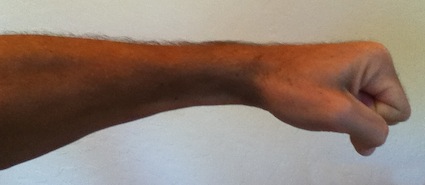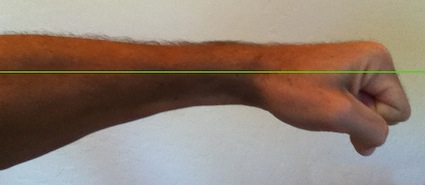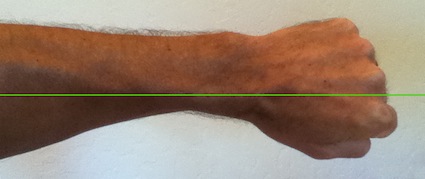The Science of a Wing Chun Punch - Part 1
A look at the Wing Tsun vertical punch as compared to the commonly used horizontal punch whether it be a jab, a roundhouse or a cross
Let's start with analyzing the horizontal punch.
Most people that employ this punch attempt to create a flat surface to strike with, which tends to line up the top of their fist with the top of the forearm as in the image below.

If you follow the line of force as it would travel down the forearm i.e. the middle of the forearm, you will notice that where it terminates at the fist it is off center of the contact surface.

Newtonian Physics dictates that this will apply more counter force to the lower part of the fist causing the wrist to bend in that direction and this can cause pain or damage. Thus most fighters employing this punch have to tape up their wrists or, if using gloves, have a wrap around the wrist adding support to compensate for this effect.
Now let's look at the same alignment from the top. Most people using the horizontal punch are taught to make contact with the knuckles of the pointer and middle finger. Again, following the line of force as in the image below, we see there is a similar offset from center of the contact surface.

In my view there are multiple problems with this type of punch that the Wing Chun vertical punch does not share, of which I will now address.
- Due to the offset of the lines of force, as described above, and the angle of the arm in relation to the opponent one is not delivering as much force as one could. My student, Sihing Rusty, wrote a very good paper on this aspect that I will post, with his permission.
- If this punch is delivered, as it often is, with the elbow in a high position then again less force is transferred than is possible because the body is not behind it and thus mostly arm muscles are delivering force. Unless of course one is using the hips and upper body adding more power to the punch. The problem with this is that one telegraphs the intent thus making it easier to defend. This will also consequently take more energy meaning one will have less with which to continue combat.
A short interlude that leads into the next problem.
I once read a paper on the delivery of force of a punch that stated if one could employ all the muscles that can be used while punching, one could move six cars! That's a lot of force. Of course the consequence would probably be the utter destruction of every bone from the knuckles down to the hips, so the body has a natural tendency to protect itself from this type of damage: only ten percent of the muscles are used to deliver the punch while ninety percent of them are pulling back, that’s fighting yourself ten to one! So...
- With the horizontal punch the fist tends to be tightly curled from its inception. If you observe the muscles in the forearm you will notice how this action tenses most of them. This is energy or force that is held rather than being transferred to the opponent.
- If the elbow is in a high position one is neglecting the protection of the ribs, liver, spleen etc. that the elbow offers.
In Part 2 I’ll examine the Wing Chun vertical punch which I’ll post shortly.
Thanks for reading.
